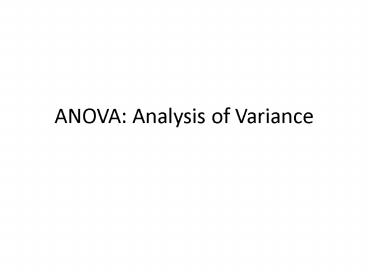ANOVA: Analysis of Variance PowerPoint PPT Presentation
1 / 21
Title: ANOVA: Analysis of Variance
1
ANOVA Analysis of Variance
2
Analysis of Variance Designed Experiments
- When the data were obtained according to
certain specified sampling procedures, they are
easy to analyze and also may contain more
information pertinent to the population
parameters than could be obtained using simple
random sampling - Design of an Experiment the procedure for
selecting sample data
3
Experimental Design Terminology
- Factors independent variables that may be
related to a response variable y - Level the value that is, the intensity
setting assumed by a factor in an experiment - Treatments the combination of levels of the
factors for which y will be observed. The term
treatments is used to describe the factor-level
combinations to be included in an experiment
because many experiments involve treating or
doing something to alter the nature of the
experimental unit, the object upon which a
measurement is made.
4
Example Suppose that an experiment is conducted
to measure the hardness y of a new type of
plastic as a function of two factors, the
pressure and temperature at the time of moulding.
If the hardness of the plastic is measured at
pressures 200, 300, and 400 pounds per square
inch (psi) and at temperatures 200 and 300
degrees Fahrenheit (?F), then pressure is at
three levels and temperature is at two
levels. The combinations of levels of the
factors for which y will be observed are called
treatments. For example, if the hardness of the
new plastic is measured for each of the six
pressure-temperature combination, (200psi,
200?F), (300psi, 200?F), (400psi, 200?F),
(200psi, 300?F), (300psi, 300?F), (400psi,
300?F), then the experiment would involve six
treatments.
5
Definition 14.1. The independent variables that
are related to a response variable y are called
factors. Definition 14.2 The intensity setting
of a factor is called a level. Definition 14.3
A treatment is a particular combination of levels
of the factors involved in an experiment.
6
The design of an experiment involves the
following four steps 1. Select the factors to
be included in the experiment and identify the
parameters that are the object of the study.
Usually, the target parameters are the population
means associated with the factor level
combinations (i.e. treatments). 2. Decide how
much information you want to acquire that is,
decide upon the magnitude of the standard
error(s) that you desire. 3. Choose the
treatments (the factor level combinations) to
be included in the experiment and determine the
number of observations to be made for each
treatment. 4. Decide how the treatments will be
assigned to the experimental units.
7
Completely Randomized Designs
Definition 14.4 A completely randomized design to
compare p treatment means is one in which the
treatments are randomly assigned to the
experimental units, or in which independent
random samples are drawn from each of the p
populations.
8
(No Transcript)
9
(No Transcript)
10
(No Transcript)
11
(No Transcript)
12
(No Transcript)
13
(No Transcript)
14
(No Transcript)
15
(No Transcript)
16
(No Transcript)
17
(No Transcript)
18
(No Transcript)
19
(No Transcript)
20
Example
Six different machines are being considered for
use in manufacturing rubber seals. The machines
are being compared with respect to tensile
strength of the product. A random sample of 4
seals from each machine is used to determine
whether the mean tensile strength varies from
machine to machine. The following are the
tensile-strength measurements in kilograms per
square centimeter x 10-1.
Perform the analysis of variance at the 0.05
level of significance and indicate whether or not
the mean tensile strengths differ significantly
for the 6 machines.
21
Sum of Squares Unequal Samples

